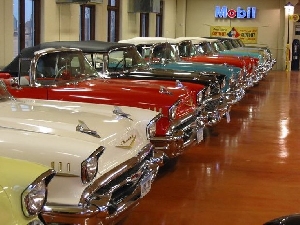 I have always found the relationship between humans and their automobiles interesting. I contend what we drive greatly impacts how we drive. To illustrate, I believe there are basically three distinctively different classes of people who drive: those who just want a basic form of transportation, those who use it as a status symbol, and those who have a love affair with their vehicle, a sort of connoisseur. Each group sees the automobile differently and, as such, treats it differently.
I have always found the relationship between humans and their automobiles interesting. I contend what we drive greatly impacts how we drive. To illustrate, I believe there are basically three distinctively different classes of people who drive: those who just want a basic form of transportation, those who use it as a status symbol, and those who have a love affair with their vehicle, a sort of connoisseur. Each group sees the automobile differently and, as such, treats it differently.
BASIC TRANSPORTATION
Those who just want a basic form of transportation are more impressed by the functionality of the vehicle as opposed to aesthetics. Price, reliability, gas mileage, maintenance, and safety are more important than contoured lines, paint, and leather bucket seats. To them, the automobile is a necessary evil; it is nothing more than a tool to move them from point A to point B. As such, it is essentially no different than the role the horse played in the 1800's. You feed it, you give it basic grooming, and you ride the heck out of it.
I find these types of people do not establish any emotional ties to their vehicles yet tend to hold on to them a lot longer than most as they wish to get their money's worth out of it. If the car is to be used for nothing more than transportation, they typically buy small to mid-sized cars. However, they are more inclined to buy something bigger if they have to transport samples and paper work, such as what salesmen do, or children. Construction workers are more inclined to buy trucks.
The "basic" people represent the lion's share of drivers on the road. As such, you must remember they are only interested in reaching their destination. Some will be overly conservative, particularly our seniors, some will go with the flow, some will be hell-bent on reaching their objective, and others will be preoccupied on the phone, shaving, reading, applying makeup or fixing their hair as they consider driving a horrendous waste of time. It is this last group that is the most dangerous as they are more interested in their distraction than driving the car.
STATUS SYMBOLS
Those who see their vehicle as a status symbol are trying to make a statement of some kind; either they are "sporty", filthy rich, or use it as a means of attracting the opposite sex thereby acting as a phallic symbol. Unlike the "basic" people, looks are of paramount importance. Consequently, they either buy the fastest gas guzzlers, the most opulent luxury vehicles, or something in-between. Electronic trinkets are important here as the vehicle is considered more as a toy than anything else.
The status people have emotional ties to their vehicles only until the next model comes out whereby they trade-up at every opportunity. In other words, owning a car for one year is considered an eternity.
On the road, the "status" people have two different driving personalities: they are either fast and reckless, thereby giving the impression they are eccentric and have plenty of money to burn, or they drive rather conservatively, conscious of their investment.
CONNOISSEURS
Those who truly love cars possess an in-depth understanding of automobiles and a deep seeded appreciation for the design and engineering of the vehicle. Guys like Jay Leno come to mind, as well as people who participate in the many classic car shows across the country. They buy rare cars for several reasons; to remind them of a bygone era, the sheer love of automotive engineering, and as an investment. They drive their car not because they have to, but because they want to as they truly appreciate the automobile as a remarkable engineering achievement.
The "connoisseurs" are passionate about their vehicles and develop strong attachments to them. However, most will reluctantly part with them if the price is right, and will buy something else to work on. They spend their idle time scouring eBay looking for spare parts, visiting auto auctions, and carefully inspecting different vehicles at car shows. To them, it is a serious hobby, requiring them to possess an in-depth knowledge regarding their subject and a close attention to detail.
Those that fall into this category are perhaps the best drivers on the road. They are acutely aware of the capabilities and limitations of their vehicles and drive defensively in order to protect them. They are typically the safest drivers on the road.
DIFFERENCES
The basic difference between the three schools of thought is how the human being perceives the automobile, either as nothing more than a tool or commodity, an expression of one's personality, or as a prized investment. These perspectives ultimately dictate our driving habits and how we treat the vehicle. We either see it as nothing more than a mule or workhorse, a stallion out to stud, or a fine quarter horse suitable for racing.
These distinctively different perspectives present an interesting dilemma for automotive manufacturers in terms of what types of cars they should be building. Do they develop something for the masses whereby what they lack in profit-margin can be made up for in volume? Or do they develop a line of luxury cars which will feature a much higher price tag? Or do they try to design a "classic" which will stand the test or time? I guess it ultimately depends on who you want to sell to: basic people, the status seekers, or the investors. Each has a different perspective and each wants something different.
Keep the Faith!
Note: All trademarks both marked and unmarked belong to their respective companies.
 Tim Bryce is the Managing Director of M. Bryce & Associates (MBA) of Palm Harbor, Florida and has over 30 years of experience in the management consulting field. He can be reached at timb001@phmainstreet.com
Tim Bryce is the Managing Director of M. Bryce & Associates (MBA) of Palm Harbor, Florida and has over 30 years of experience in the management consulting field. He can be reached at timb001@phmainstreet.com
For Tim's columns, see:
http://www.phmainstreet.com/timbryce.htm
No comments:
Post a Comment